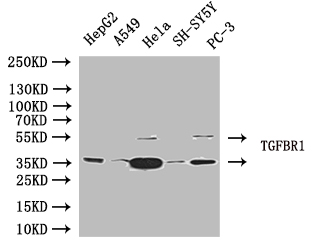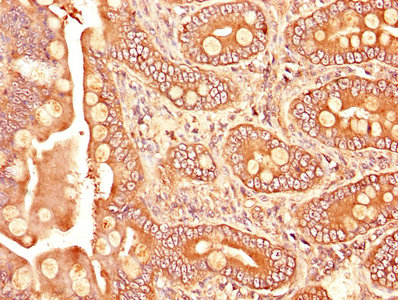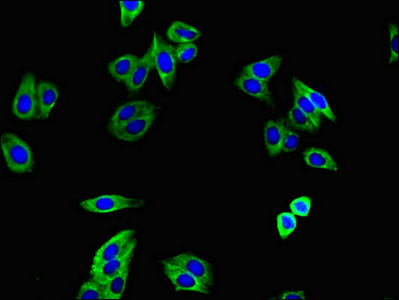
Western Blot Positive WB detected in: Jurkat whole cell lysate, SH-SY5Y whole cell lysate All lanes: TGFBR1 antibody at 4microg/ml Secondary Goat polyclonal to rabbit IgG at 1/50000 dilution Predicted band size: 56, 57, 48 kDa Observed band size: 56 kDa
TGFBR1 Antibody
CSB-PA023451LA01HU
ApplicationsImmunoFluorescence, Western Blot, ELISA, ImmunoHistoChemistry
Product group Antibodies
ReactivityHuman
TargetTGFBR1
Overview
- SupplierCusabio
- Product NameTGFBR1 Antibody
- Delivery Days Customer20
- ApplicationsImmunoFluorescence, Western Blot, ELISA, ImmunoHistoChemistry
- CertificationResearch Use Only
- ClonalityPolyclonal
- ConjugateUnconjugated
- Gene ID7046
- Target nameTGFBR1
- Target descriptiontransforming growth factor beta receptor 1
- Target synonymsAAT5; activin A receptor type II-like kinase, 53kDa; activin A receptor type II-like protein kinase of 53kD; activin receptor-like kinase 5; ACVRLK4; ALK5; ALK-5; ESS1; LDS1; LDS1A; LDS2A; MSSE; mutant transforming growth factor beta receptor I; serine/threonine-protein kinase receptor R4; SKR4; tbetaR-I; TBRI; TBR-i; TGF-beta receptor type-1; TGFR-1; transforming growth factor beta receptor I; transforming growth factor-beta receptor type I
- HostRabbit
- IsotypeIgG
- Protein IDP36897
- Protein NameTGF-beta receptor type-1
- Scientific DescriptionTransmembrane serine/threonine kinase forming with the TGF-beta type II serine/threonine kinase receptor, TGFBR2, the non-promiscuous receptor for the TGF-beta cytokines TGFB1, TGFB2 and TGFB3. Transduces the TGFB1, TGFB2 and TGFB3 signal from the cell surface to the cytoplasm and is thus regulating a plethora of physiological and pathological processes including cell cycle arrest in epithelial and hematopoietic cells, control of mesenchymal cell proliferation and differentiation, wound healing, extracellular matrix production, immunosuppression and carcinogenesis. The formation of the receptor complex composed of 2 TGFBR1 and 2 TGFBR2 molecules symmetrically bound to the cytokine dimer results in the phosphorylation and the activation of TGFBR1 by the constitutively active TGFBR2. Activated TGFBR1 phosphorylates SMAD2 which dissociates from the receptor and interacts with SMAD4. The SMAD2-SMAD4 complex is subsequently translocated to the nucleus where it modulates the transcription of the TGF-beta-regulated genes. This constitutes the canonical SMAD-dependent TGF-beta signaling cascade. Also involved in non-canonical, SMAD-independent TGF-beta signaling pathways. For instance, TGFBR1 induces TRAF6 autoubiquitination which in turn results in MAP3K7 ubiquitination and activation to trigger apoptosis. Also regulates epithelial to mesenchymal transition through a SMAD-independent signaling pathway through PARD6A phosphorylation and activation.
- ReactivityHuman
- Storage Instruction-20°C or -80°C
- UNSPSC12352203


